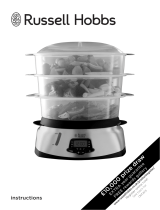
Issue01 28/5/2018 6
Notes:
Before using for the first time, fill to the MAX level with clean
water, fit the cover and allow the steamer to work for a few
minutes. Turn off the steamer and discard the hot water. Wash
the loose parts (steamer bowls, drip tray, stacking rings steam
tube and cover) in hot water with a little washing up liquid. Rinse
and dry thoroughly. Alternatively these parts may be washed in
a dishwasher.
The timer will operate regardless of whether the steamer is
plugged in. Always check that the power lamp is illuminated.
When the reservoir is empty (and reaches a specific temperature)
the steamer will automatically cut off and the power light will
extinguish. In this case, switch off the steamer at the plug, allow
it to cool (minimum 4 minutes) add water to the reservoir via the
refill point and resume the cooking process
General cooking advice
A single layer of food steams faster than several layers.
Position foods that require longer cooking in the lower steamer
bowl and those that require the shortest cooking time in the
upper bowl.
If using more than one steamer bowl, ensure greasy foods or
those with strong flavours are placed in the lower bowls to
minimise transfer of taste.
For best results do not cook meat or poultry thicker than 2.5cm
(1”).
If steaming meat & poultry, position the meat in the lowest bowl
so that the juices from raw or partially cooked meat cannot drip
onto other foods.
The cooking time will vary according to the shape, thickness and
composition of the food.
Smaller pieces will cook quicker than larger pieces. For best
results, ensure pieces of food are similar in size. If pieces vary in
size then layering is required. Place smaller pieces on top.
The cooking time is longer for a larger quantity of food than a
smaller quantity, for example 1kg of cauliflower florets will need
longer to steam than 0.5kg.
If steaming food with a bone the steaming time will need to be
extended.















